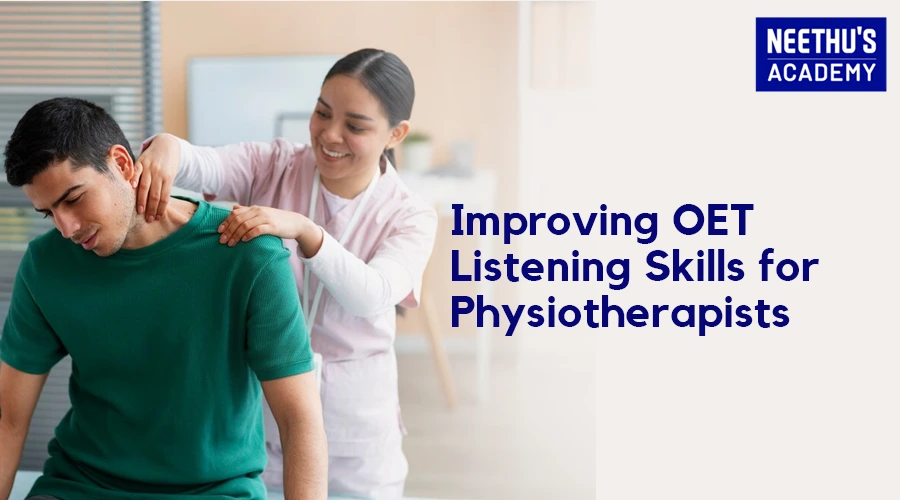Top 10 OET Speaking Tips to Improve Fluency
Among the several components of the OET, the Speaking sub-test is crucial and evaluates your proficiency not only in language but also in managing real healthcare scenarios with fluency and professionalism.
The speaking sub-test is usually the most difficult for many candidates. It always needs rapid thinking, clarity in communication, and the ability to interact well with patients with kindness but yet being professional. As a nurse, doctor, physiotherapist, or other medical personnel, you’ll need fluency in the OET-speaking test not only to pass but to shine in your future career.
Now, let’s explore some practical strategies that will assist you in improving your speaking skills, enhancing role-play performance, and mastering techniques of communication in healthcare settings.
Overview of the OET Speaking Sub-Test
The OET Speaking sub-test features two role-play tasks. You will need to have a professional conversation with both an imaginary patient or caregiver. The role-plays are real-life healthcare scenarios relevant to your profession. You will be judged in your ability to interact, explain, advise, and empathize when using appropriate medical terminology.
What Does the OET Speaking Sub-Test Assess?
The OET speaking sub-test consists of the following key areas:
Communication Skills: The skill to keep communication with the patient and convey whatever information is relevant in a professional manner.
Empathy and Professionalism: Showing empathy and professionalism are extremely important while dealing with patients.
Clarity and Coherence: The ability to speak clearly, organize their thoughts, and present information in an orderly and structured manner.
Medical Vocabulary: Students must know the proper usage of medical terms.
Fluency: How smoothly you convey your ideas without pause or hesitation, fillers, or lengthy silence.
These performances are given scores to help you ensure that you can communicate well in the healthcare environment in English.
Why Fluency is Important for OET Speaking
Fluency in the OET Speaking sub-test is the smoothness and coherence of your speech. It is needed because the healthcare professional needs to hand over vital information quickly and accurately. In real healthcare settings, patients often need to understand their condition and treatment as quickly as possible. Fluency allows you to get your message across clearly without causing confusion or misunderstandings. A fluent response also reflects confidence and professionalism, which are highly valued by examiners.
Top 10 OET Speaking Tips
Improvement in fluency while speaking takes time, practice, and the right strategies. Here are 10 essential tips to help you improve fluency and achieve success in the OET Speaking exam.
1. Practice role-plays regularly
Regular practice of role-plays is a quite useful way to make progress with OET speaking fluency. Role-play is the core part of the OET Speaking subtest, and practicing various scenarios will make you feel comfortable with the exam format. Whether you practice with a study partner, a mentor, or a professional coach, regular role-play exercises will build confidence.
Examples: If you are a nurse, you can pretend to discuss post-operative care for a patient. The more you role-play that situation, the more comfortable you will become with the medical jargon, and your language will flow better.
2. Clearness and Simplicity
Generally, patients in healthcare settings require the use of simple and clear language. Avoid speaking complexly; patients are likely to be confused by jargon or overly technical terms. Use clarity and simplicity while speaking during your OET speaking practice session.
Tip: Create a list of common medical phrases before the exam and practice explaining them in simple terms. Instead of saying, “You are experiencing a myocardial infarction,” try “You are having a heart attack.” Understandably, plain language ensures your message is transmitted as intended and helps maintain fluency.
3. Build Active Listening Skills
Fluency isn’t just about speaking; it’s equally about listening. Active listening is a vital skill, especially when interacting with patients. Understanding the patient’s concerns and responding appropriately will keep the conversation flowing naturally.
During the role-play, practice listening attentively and responding to the patient’s needs. This will help you avoid long pauses or misunderstandings
Example: If a patient says that they are worried about a procedure, pay close attention and validate those feelings before reassuring them.
4. Build Strong Vocabulary
Clear expression requires a strong vocabulary; do not need to memorize all medical terms; just understand the terminology of the health care profession; further practice using simpler synonyms for complex medical words would also help you to explain things better and with a flow.
For instance, as a doctor, you would like to practice terms associated with diagnostics and treatments as well as medical conditions. As a nurse, you focus on medication, symptoms, and even more patient care.
5. Employ Transition Words to Maintain Flow
Transition words such as “firstly,” “in addition,” “for example,” and “to clarify” will help you to keep a conversation going. These words are simply connectors which join your ideas and provide logical threads of your thoughts together.
Using transition words will keep you from having abrupt pauses or digressions. Moreover, it will make your speech seem more organized, something that is very important for the OET speaking sub-test.
Example: “Okay, first let me tell you how it’s done. And then I will detail the recovery after the procedure.”
6. Record and Review Your Practice
Use self-recording of your practice as a roleplay to check your fluency. Listen to the recording to look for areas you need to work on. Are you speaking too fast or too slow? Do you still use words like “um” and “ah”? These small details might be problematic for your fluency.
Recording will also enable you to monitor your progress over time. You should listen to the recordings critically and note down where you want to improve more. If you do not understand some terms or phrases, research them and do practice again.
7. Empathy and Professionalism
Fluency in speaking isn’t only about speaking quickly and smoothly, but also the manner of engaging a patient. To be successful in OET speaking, you must, most importantly, evoke empathy and professionalism. Use a compassionate tone and listen actively and show how well you care about your patient’s health.
Example: If the patient is anxious about his or her treatment, sympathize with him or her by saying, “I understand how this situation might be stressing you out, but we shall treat you properly.”
8. Control Your Speaking Pace
You should speak at a consistently moderate pace throughout the OET Speaking test. Speaking at a rate that may be too fast will make your speech unclear while speaking at too slow of a pace gives the impression of hesitancy. Find a pace that lets you convey your thoughts eloquently and yet fluently.
Read at a comfortable pace instead of rushing. You might want to time yourself in practice so that you’re speaking at an appropriate rate.
9. Emphasis on Pronunciation and Stress.
Clarity and fluency depend upon proper pronunciation. If a patient cannot understand your pronunciation, they cannot clearly understand your instructions or explanations. Practice your pronunciation of medical terminology and common vocabulary by yourself, paying again careful attention to syllable stress and vowel sounds.
Intonation or the rise and fall of your voice—is also vital for natural speech. Remember that your intonation changes with different statement types (questions, instructions, empathy).
10. Simulate Exam Conditions
Practice exercises under real exam conditions will help you feel confident and be more precise when managing your time. You must set a timer for each role-playing activity and practice answering within a given time frame. This will help you stay on track for enough time to complete your response within the time limits set for the exam.
Also, practice under distractions or conditions that simulate the exam setting so that you get used to the pressure and environment.
The Bottom Line
Fluency in OET speaking needs practice, dedication, and the right strategy. Follow the top 10 OET speaking tips discussed in this blog to improve your communication skills, to control your pace while speaking, and enhance your confidence level to successfully pass the OET exam. Consider professional coaching as the additional support you need to achieve your goals. Start practicing these strategies today to improve your OET speaking performance and move one step closer to success in your healthcare career.
Frequently Asked Questions





